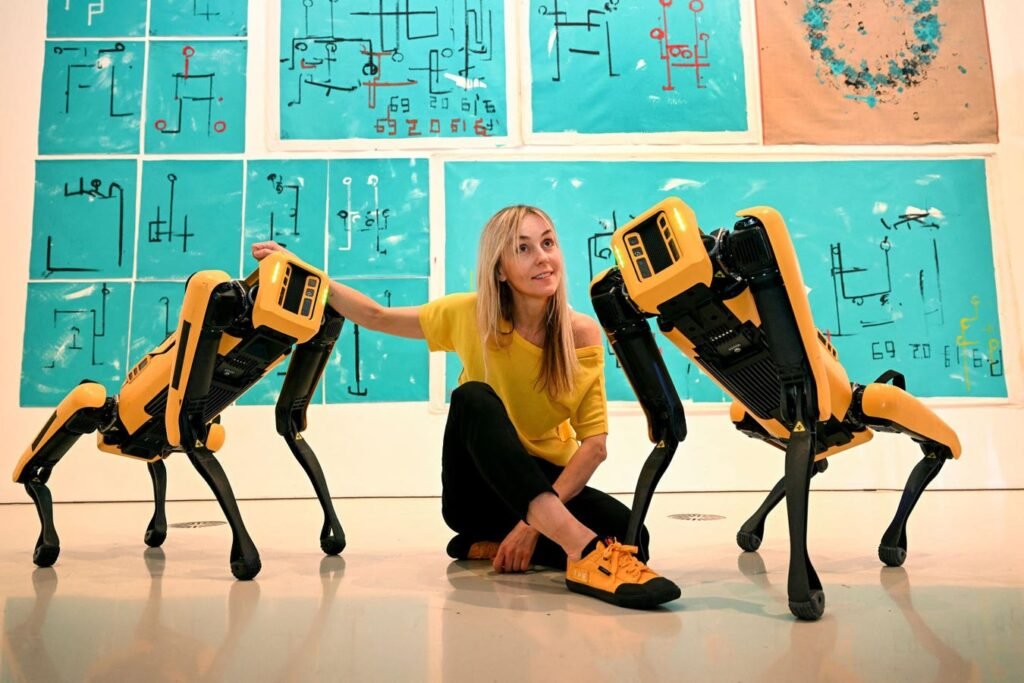Polish artist Agnieszka Pilat poses with her dog-painting robot artwork – Basia Spot and … [+]
A few weeks ago I had the opportunity to connect with a colleague who is the Chair of the Computer Science Department at one of the top universities in the United States. He told me that their initial AI class has 10,000 students. They cannot keep up with the rate of interest. Similarly, an undergraduate student at another prestigious US university told me he can’t get into an AI class – it’s all full.
What is a moving train?
I like to think of the AI world as a moving train. Innovations come out every day. Because many of these innovations are publicly available as open source software, as soon as a new entry appears, others build on it and release further innovations. From a research perspective, a recent analysis suggests that, as early as 2019, 3 new papers were submitted to Arxiv (a respected AI document repository) every hour, over 148 times faster than in 1994. The same analysis suggests that over 5 researchers are entering the field of artificial intelligence every hour since 2019 The AI train is moving very fast and gaining speed every day.
How to get on the train?
This is the question most people ask me – whether they are parents of a 6th grader or a professional with decades of technical experience but not in AI. Everyone sees the train moving. Many of them feel that it is gaining momentum. They stand on the sidelines wondering how to get on a train that never stops. They wonder if they are ready, but they also feel that waiting is not wise. Every day they don’t get on the train, it gets harder to get started. So how does one ride the train?
- In a previous post, I provided a framework for AI Literacy called the 4 C’s – Concepts, Context, Competence and Creativity. The basic idea is that AI is a big space and it is not possible to understand everything deeply at first. By understanding some of the key concepts, how to use them (Context), having some hands-on experience (Ability), and matching it to problems of interest (Creativity), you can begin to tackle the situation.
- Start as early as possible. K-12 is not too early. The anecdotes above suggest that K-12 may be just the right time—and waiting may be too late. A recent survey of AI Projects in Science Fairs suggests that AI can be a very powerful complement to other STEM subjects at the K-12 level, creating an opportunity to learn early and thrive.
- Top down (start by driving the train – don’t start with the internals of the engine). A mistake some students make is feeling like they can’t even start learning AI until they learn more math or coding. This is like trying to figure out how the engine works while the train is speeding away. By the time you learn how one type of engine works, the train will be moving even faster and probably with a whole new kind of engine.
Takeaway: Driving the Train
- Jump up. Try some AIs. Learn how they work conceptually. Dive as deep as is appropriate for your interests and background.
- When a new type of AI comes out – try it! While AIs used to be hard to find and access, they are no longer so. Many new AIs are readily available on websites. Try them out and form an opinion based on what you know.
- Pick and choose. As you test new AIs, you’ll develop an opinion about what’s useful for you—whether you’re a K-12 teacher, lawyer, doctor, etc. The AI space is too big for everyone to know everything. The key is to choose. It can be difficult at first, but after you’ve tried a few AIs, you’ll have a stronger opinion of what’s right for you.
- Keep learning. Success does not mean deep learning a type of AI that is already outdated. Success means knowing how to analyze the flow of new developments, choose what works for you, ask good questions and use new technology to thrive.
